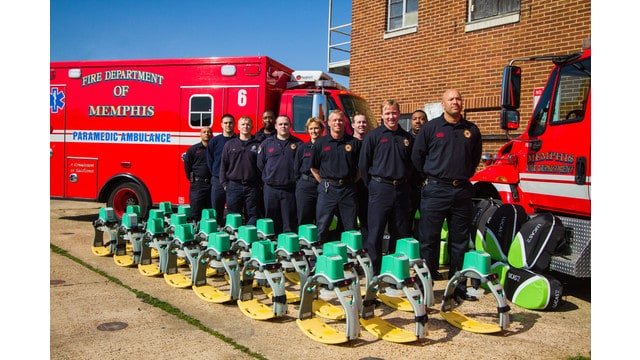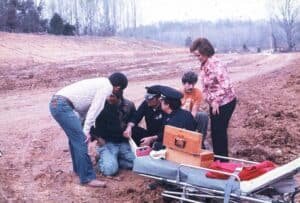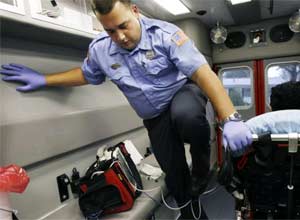
Memphis Fire Department Emergency Medical Services, The History:
By 1965, the City of Memphis had received many complaints from its citizens, regarding the lack of adequate training, lack of ambulance equipment, and poor patient care against several existing primary private ambulance operators. At that time, the city ambulance service was handled by combinations of funeral homes and private entities which served specific areas and were dispatched by the Memphis Police Department. The police department also operated an “Emergency Unit” station wagon which was manned by two first- aid trained police officers and other emergency equipment, and, who mainly responded to major incidents in the city
In the fall of 1965, the City of Memphis Commission form of Government, responded to the growing complaints by adopting the “Model Ambulance Ordinance,” making it an actual enforceable city law. This model legislation had been originally developed by the American College of Surgeons several years earlier as a strategy to help improve the level of ambulance equipment and training in those major cities that were willing to pass it…cities such as Houston and Dallas, two of the first. The efforts of the American College of Surgeons actually pre-dated the historic “White Paper” entitled “Death & Disability – The Neglected Disease of a Modern Society,” which would emerge the following year. Upon hearing of the ordinance passage, several of the existing private services immediately protested the new regulations and soon notified city officials that they would no longer respond to police dispatched emergency calls. A brief review was then quickly commissioned by the Memphis Fire Department to determine how its existing resources could support the take-over of a city-wide ambulance service and meet needed requirements. The initial research called for at least 8 ambulances, with 2 additional vehicles to be purchased as stand-by or reserve units. Its reported findings were then forwarded to the Mayor by then, Memphis Fire Chief Edward A. Hamilton.
In November of 1965, following the review of the current ambulance system, the City of Memphis voted to grant authority to the Memphis Fire Department to establish a city-wide emergency ambulance system/service for its citizens. Approximately $135,000 was budgeted to purchase, equip, and staff 8 ambulances. The fire department was selected because of its existing strategically located fire stations, superb training, and the existence of personnel already trained to the 20 hour American Red Cross Advanced First Aid level. The department also had approximately 80 in-house Red Cross First Aid Instructors out of the 926 men on the department at that time. Memphis Fire made the decision to call the vehicles, “Emergency Units” or “EU” as opposed to the more formal term “ambulances,” in order to emphasize their intended use for emergency patient needs only.
Under the direction of Chief Eddie Hamilton, a formal implementation plan for the new Emergency Ambulance Service was developed in January of 1966, consisting of 10 crucial steps to make us fully operational:
1. Research and develop specifications for our Emergency Unit vehicles, including standard equipment that each unit would carry.
2. Determine which Memphis Fire Stations the Emergency Units should be assigned, based on past call volume.
3. Establish administrative and standard operating procedures based on meetings and consultations with area hospitals, physicians, and other officials.
4. Develop a training program for both the Emergency Unit Attendant and Emergency Unit Driver.
5. Begin a selection and processing process to recruit new members to the Memphis Fire Department Emergency Service Bureau.
6. Work with local hospital and physicians to develop an emergency care training program for the new members.
7. Design and institute a public relations program that would educate the public, press, radio and television media about how to access the new service.
8. Determine a specific target date to place all emergency units into operation at selected fire stations.
9. Regularly review and revise both administrative and operational procedures as required.
10. Effectively document operational information so that strategic projections could be accurately provided for future needs.
It was determined that the Memphis Fire Department’s Apparatus Maintenance Bureau would develop ambulance specifications for the Emergency Units and the standardized equipment they would need. The Fire Alarm Office reviewed past alarm and police response records and made predictions of the areas that the department would most likely respond to the most. The Memphis Fire Department Training Bureau was tasked with the development of administrative and operational procedures, as well as design the training program. The Memphis Fire Department Bureau of Personnel was tasked in developing an effective in-house recruiting program, asking current Memphis Firefighters to step forward and volunteer for duty and assignment to the Emergency Units. An additional in house Memphis Fire Department Clerk was hired to manage the ambulance billing process.
Public Service Announcements and news accounts quickly made Memphis citizens aware of the emerging new service. An additional city ordinance was introduced and passed, allowing for the purchase, operation and maintenance of the city-wide emergency unit fleet. The ordinance also established a fixed fee of $15.00 for ambulance transport, as well as provide for “no charge” if transportation to the hospital was not needed. The ordinance mandated the new service would cover the city limits of Memphis only. Also in the mandate, no city employee would be charged for transport if they were injured on-duty, requiring transport to an area hospital. It was also decided that each Emergency Unit would be staffed with an apparatus operator (driver) and 2 Memphis Firemen to help ensure adequate manpower and manage the transport and emergency first aid care of the patient.
The specifications required that each vehicle have a minimum 338 horsepower V-8 engine, automatic transmission, 146.8 inch wheelbase, power brakes, air-conditioning, and both a piped in-line oxygen and manifold suction system. Required equipment included: a multi-level stretcher, folding road stretcher, extensive first aid kit, Thomas half-ring splint, board splints, ambu-bag, fire extinguisher, airways, two negative pressure resuscitators, an inflatable splint kit and other necessary equipment items and supplies as deemed necessary. The Superior Coach Company in Lima, Ohio won the bid and was selected to build and deliver 8 ambulances with the possibility of building two more if a budget supplement would allow for such.
Chief Hamilton also met with representatives of all the Memphis area hospitals to finalize preparation of our new Emergency Services. Each hospital agreed to install a special red “Hotline” phone in their emergency rooms to allow instant communications between the hospital’s emergency room (ER) and dispatcher in the Fire Alarm Office. When an Emergency Unit transported a critical patient to the hospital, the driver of the Emergency Unit would advise the FAO Dispatcher, who would then automatically ring the hospital ER phone, to which the Unit was transporting, and advise Emergency Room staff of the pending fire department emergency unit arrival.
An all day, initial introductory training program, lasting several days, was approved and taught by area physicians and nurses in conjunction with the MFD Training Bureau, designed to build upon the fireman’s existing Red Cross advanced first aid training level. Topics included patient handling, defensive driving, childbirth, coronary patients, psychiatric, radio communications, orthopedic, victim rescue and extrication, crime scene protocols, airport response, diseases, specific Emergency Room protocols, as well as new administrative and operational rules.
The new service was fully implemented in the winter of 1966 and averaged approximately 8,000 runs during its first year of service. In years following, the Memphis Fire Department’s Emergency Ambulance Service would confront two tragedies that would capture the world's attention. On April 4, 1968, Memphis Fire Department Emergency Unit 1 (EU-1), based downtown at Station #1, responded with Engine 1 to the Lorraine Motel, just south of the downtown district. On an upper motel balcony, the three member ambulance crew discovered Dr. Martin Luther King in grave condition from a gunshot wound. They immediately applied critical first aid measures and rapidly transported him to a nearby hospital. On August 16, 1977, another MFD Emergency Unit, EU-6, running out of Station # 29, would respond to the Graceland Estate and transport music legend, Elvis Presley, accompanied by Elvis’ personal physician to nearby Baptist Memorial Hospital on Union.
In 1968, a number of Memphis Fire Department Emergency Unit Personnel attended the newly established three and four day 32 hr. Advanced Training Emergency Care Course, held in various major U.S. cities, including Memphis. These programs, designed to build upon the Red Cross Advanced First Aid level, were sponsored by both a prominent local orthopedic surgeon and the American Academy of Orthopedic Surgeons.

By the early 1970’s, the Memphis Fire Department had exchanged the Superior Coach Company vehicle for a Chevrolet Type 1 modular ambulance, built by Road safe Emergency Vehicles (REV) in nearby Shelbyville, Tennessee. The department also upgraded all ambulance personnel training to the new 81 hr. Department of Transportation (DOT) Emergency Medical Technician (EMT-A) basic curriculum. By the mid 70’s, the department had paramedic level personnel, EKG telemetry and advanced life support capability. The State of Tennessee also fully adopted the new federal DOT KKK-1822-A ambulance standards and mandated that all state licensed ambulances must be white in color, with an orange stripe and displays with the wording, “AMBULANCE” as well as the new prescribed blue “Star of Life” emblem. This forced a great departure from our traditional Memphis Fire Department “red fire ambulance” that had been used since the services inception back in 1966. As the decades passed, more ambulances were added, training expanded, and equipment upgraded.
Several years ago, the Memphis Fire Department found a means to exempt itself from the mandated white and orange color scheme and changed back to a mostly traditional red rescue ambulance color. The MFD, under the direction of then, Fire Chief Richard Arwood and EMS Deputy Chief Gary Ludwig, felt it was essential to return to red in order to, symbolically, demonstrate to all MFD personnel and the public, that EMS was an essential and primary element in modern municipal metropolitan fire services. Going through the State of Tennessee Legislature to change the rules, and headed up by the Shelby County delegation, a mandate was introduced and passed that included the metropolitan cities of Memphis, Nashville, Knoxville, and Chattanooga, authorizing, if they wished, the change of the color of ambulances to the same color as their fire trucks.
By 2004, the MFD EMS Service found the ranks down by more than 100 paramedics, resulting in overtime costs exceeding $10 million dollars annually, to say nothing of the negative effects on fire personnel and the remaining paramedics who were required to work huge levels of overtime. The primary supplier of paramedics, Southwest Tennessee Community College, found it impossible to keep up with the demand for these highly trained individuals in the MFD. Memphis Fire realized the only way to get and maintain a full paramedic rank structure was in the ability to train their own. Again, our state legislators helped the department out with the appropriate state legislation, which now allows the cities of Memphis, Nashville, and Knoxville to offer their own “internal” education programs. These programs MUST meet the strict state EMS commission standards and oversight however. It was a tedious process to gain that approval, but it was accomplished by the dedicated efforts of key EMS personnel, and it is maintained by them to this day. Neither Nashville nor Knoxville have chosen to take those complicated steps toward state approval.

Simultaneously, the City of Memphis Human Resources agreed to allow the MFD to recruit paramedics from other states, offering $10,000.00 bonuses and moving expenses, as incentives to come to work for Memphis. The State of Ohio had a large excess number of paramedics, and Memphis Fire went after them, sending a personal letter to each one of them in the state. Many responded and came to Memphis. By 2008, the paramedic ranks in the MFD were essentially filled, achieving a fully filled status in early 2009 when the Fall class of 2008 recruits were graduated. For the first time, MFD enjoyed the capability of being able to train its own members and to sufficiently sustain its needed supply and resupply of Paramedics, although many are presently contemplating leaving Memphis to serve in other departments due to recent changes and reductions in employee health care and retirement benefits. Some have gone as far as to take those steps and have left for other departments. No doubt, Memphis has a top-notch education program and instructional staff that delivers a state certification rate for both EMTs and Paramedics that has proven to be a successful venture for the department, maintaining independent state certification testing that is independent from the department, having no affiliation or influence from the MFD instructional staff.
As of October 2012, the Memphis Fire Department operates 36 Advanced Life Support Ambulances, 56 ALS Engines and 21 BLS Ladder companies. They also ride with 5 EMS lieutenants and one EMS Battalion Chief on each shift. In 2012, the department placed into service 8 “Alternative Response Vehicles” or ARV’s. These units have crew cab Ford chassis with an enclosed Stahl utility body. The units function as paramedic squads, equipped with forcible entry and firefighting tools. There are approximately 500 Firefighter/Paramedics and 1,100 Firefighter/EMTs in the Memphis Fire Department, with the balance of personnel being certified first responders.

Currently, the Memphis Fire Department is the largest EMS system in Tennessee and in the Mid-South, responding to approximately 106,500 EMS runs annually, and is the only non-university, in the State of Tennessee, conducting a paramedic education program in-house. The service has evolved from its humble beginning back in 1966 to that of an EMS system that serves as a model concept for the entire nation. We are proud of our Memphis Fire Department and take this opportunity to salute our Emergency Medical Personnel!